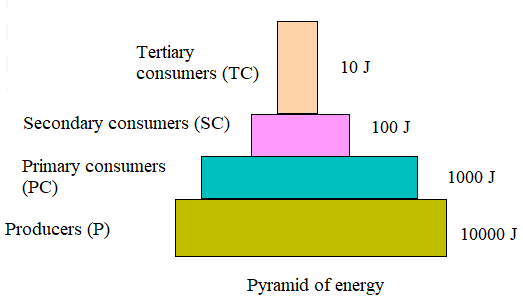
Given below is one of the types of ecological pyramids. This type represents

(A) Pyramid of numbers in a grassland
(B) Pyramid of biomass in a fallow lake
(C) Pyramid of biomass in a lake
(D) Energy pyramid in a spring

Answer
330.3k+ views
HINT:
Before we proceed into the problem, it is important to know the definition of ecological pyramids.
An aquatic ecological pyramid is a diagram that helps to illustrate the relationship between different levels of an ecosystem. It can be used as a tool for monitoring and managing ecosystems, and it may also be helpful in understanding how human activity affects the environment.
COMPLETE STEP-BY-STEP SOLUTION:

Given that the biomass of producers and secondary consumers is lower than that of primary consumers, the given pyramid illustrates the biomass pyramid in an aquatic ecosystem. The pyramid takes on an inverted shape as a result. So the pyramid in the diagram is a biomass pyramid in a lake.
The biomass pyramid in a lake habitat is symbolized by the inverted pyramid. The inverted pyramid gets smaller at the bottom. As a result, this indicates that biomass increases gradually as trophic levels rise from the lowest to the highest.
The inverted pyramid gets smaller at the bottom. As a result, this indicates that biomass increases gradually as trophic levels rise from the lowest to the highest.
Therefore, this type of pyramid represents the Pyramid of biomass in a lake.
Hence, the option C is correct
NOTE:
Tiny phytoplankton are the producers in the aquatic ecosystem. This phytoplankton multiply and expand quickly. As a result, the base of the biomass pyramid is small, with consumer biomass outpacing producer biomass. The pyramid therefore uses inverted biomass.
Before we proceed into the problem, it is important to know the definition of ecological pyramids.
An aquatic ecological pyramid is a diagram that helps to illustrate the relationship between different levels of an ecosystem. It can be used as a tool for monitoring and managing ecosystems, and it may also be helpful in understanding how human activity affects the environment.
COMPLETE STEP-BY-STEP SOLUTION:

Given that the biomass of producers and secondary consumers is lower than that of primary consumers, the given pyramid illustrates the biomass pyramid in an aquatic ecosystem. The pyramid takes on an inverted shape as a result. So the pyramid in the diagram is a biomass pyramid in a lake.
The biomass pyramid in a lake habitat is symbolized by the inverted pyramid. The inverted pyramid gets smaller at the bottom. As a result, this indicates that biomass increases gradually as trophic levels rise from the lowest to the highest.
The inverted pyramid gets smaller at the bottom. As a result, this indicates that biomass increases gradually as trophic levels rise from the lowest to the highest.
Therefore, this type of pyramid represents the Pyramid of biomass in a lake.
Hence, the option C is correct
NOTE:
Tiny phytoplankton are the producers in the aquatic ecosystem. This phytoplankton multiply and expand quickly. As a result, the base of the biomass pyramid is small, with consumer biomass outpacing producer biomass. The pyramid therefore uses inverted biomass.
Recently Updated Pages
Capping is a process in which A adenylate is added class 12 biology NEET_UG

Explain in brief the separation and isolation of DNA class 12 biology NEET_UG

Number of testicular lobules in testes is A 250 B 500 class 12 biology NEET_UG

Why are manures considered better than fertilizers class 11 biology CBSE

Find the coordinates of the midpoint of the line segment class 11 maths CBSE

Distinguish between static friction limiting friction class 11 physics CBSE

Trending doubts
What is BLO What is the full form of BLO class 8 social science CBSE

What is meant by exothermic and endothermic reactions class 11 chemistry CBSE

Which places in India experience sunrise first and class 9 social science CBSE

What are the major means of transport Explain each class 12 social science CBSE

Which are the Top 10 Largest Countries of the World?

Fill the blanks with the suitable prepositions 1 The class 9 english CBSE




